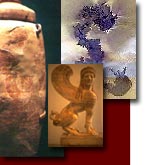| Site Map | Contacts | Links | Newsletter | |
Magnetic Reversals
{content}
 (USGC)
(USGC)
"Beginning in the 1950s, scientists, using magnetic instruments (magnetometers) adapted from airborne devices developed during World War II to detect submarines, began recognizing odd magnetic variations across the ocean floor. This finding, though unexpected, was not entirely surprising because it was known that basalt -- the iron-rich, volcanic rock making up the ocean floor-- contains a strongly magnetic mineral (magnetite) and can locally distort compass readings. This distortion was recognized by Icelandic mariners as early as the late 18th century. More important, because the presence of magnetite gives the basalt measurable magnetic properties, these newly discovered magnetic variations provided another means to study the deep ocean floor."
In 1968 the Glomar Challenger (pictured above), designed specifically for marine geology studies, including the collection of drill-core samples from the deep ocean floor, embarked on a year-long scientific expedition, criss-crossing the Mid-Atlantic Ridge between South America and Africa and drilling core samples at specific locations. When the ages of the samples were determined by paleontologic and isotopic dating studies, they provided the clinching evidence that proved the seafloor spreading hypothesis. Information & picture from http://pubs.usgs.gov/publications/text/developing.html
The Earth's Magnetic Field is Young (#242 Impact)
by Russell Humphreys, Ph.D.
"Archaeomagnetism" is the study of the magnetization of bricks, pottery, campfire stones, and other man-related objects studied by archaeologists. Iron oxides in those objects retain a record of the strength and direction of the earth's magnetic field at the time they last cooled to normal temperatures. Archaeomagnetic data taken worldwide show that the intensity of the earth's magnetic field was about 40% greater in 1000 A.D. than it is today, and that it has declined steadily since then.[7]
"Paleomagnetism" is the study of magnetization locked into rocks at the time of their formation. Paleomagnetic data show that while the geologic strata were being laid down, the earth's magnetic field reversed its direction hundreds of times. Reversals are a very severe departure from steady decay of intensity.
Both archaeomagnetic and paleomagnetic data contradict the early creationist assumption of constant decay of intensity. In 1988 I published a review paper documenting the great diversity and reliability of the data.[8]
[8] Humphreys, D. R. "Has the earth's magnetic field ever flipped?" Creation Research Society Quarterly 25 (December 1988) 89-94.
---------------------------------------------------------------------------------------------------------------------------
Deep Sea Drilling Cores
National Geophysical Data Center (NGDC)
Lamont-Doherty Earth Observatory Deep-Sea Sample Repository
The Lamont-Doherty Earth Observatory Deep-Sea Sample Repository is both an archive of sediment and rocks from beneath the ocean floor, and an archive of the digital data pertaining to the material. They are all used for research in climate, environment, and other deep-sea studies, and for education.
National Lacustrine Core Repository (LacCore)
LacCore is the US National Lacustrine Core Repository operated with grants from the National Science Foundation to the Limnological Research Center (LRC) and the Large Lakes Observatory (LLO) at the University of Minnesota. The mission of LacCore is to curate sediment cores from lakes around the world and archive the data for use by the global community of scientists interested in unlocking the secrets of past environment and climate in lake sediment cores. The repository archives cores from several expeditions in North America, South America, Europe, and Africa. The collection encompasses short (~1m) gravity cores, mid-length (~6-10m) piston cores, and very long (>200m) drill cores. All cores are available for study by qualified individuals after a moratorium period following sample collection (see the LacCore web site for policies).
Ocean Drilling Program and Deep Sea Drilling Project
The Ocean Drilling Program (ODP) curates all cores obtained by the ODP and the Deep Sea Drilling Project (DSDP). The ODP curation facilities are responsible for sample and data archiving and dissemination. This includes storing, archiving, and disseminating cores and other scientific data collected during the course of the program.
Scripps Institution of Oceanography Geological Collections
SIO, one of the first US institutions to undertake large-scale collection of sediment cores, has historically been a leader in core curation. The Sediment Core collection contains samples collected from as early as 1916. Today, the Cored Sediment Collection is a growing archive of sea-floor samples and associated data supporting a diverse variety of scientific research. The SIO geological collections are supported, in part, by the National Science Foundation.
Woods Hole Oceanographic Institution Seafloor Samples Laboratory
The WHOI Seafloor Samples Laboratory receives funding from the US National Science Foundation and is located in the McLean Laboratory on WHOI's Quissett Campus. The archive facility was established more than thirty years ago by members of the Geology and Geophysics department led by Dr. Dave A. Johnson, but contains material from the earliest days of WHOI's seagoing sampling programs. The extent of the collection is global and the 100's of tons of material currently archived have allowed scientists from diverse disciplines to undertake research on topics as varied as continental drift, climate change, mass extinctions, and the processes that lead to the evolution of chemosynthetic communities.
--------------------------------------------------------------------------------------------------------------------------
KEY LINKS:
Probing the Geodynamo By Gary A. Glatzmaier and Peter Olson. Studies of our planet's churning interior offer intriguing clues to why the earth's magnetic field occasionally flips and when the next reversal may begin.
The Earth's Magnetic Field is Young (#242 Impact) by Russell Humphreys
Is the Earth's Magnetic Field Young? by Joe Meert
On Creation Science and the Alleged Decay
of the Earth's Magnetic Field by Tim Thompson
History of Deep Sea Coring: A Core a Day Keeps 'Doc' Happy
